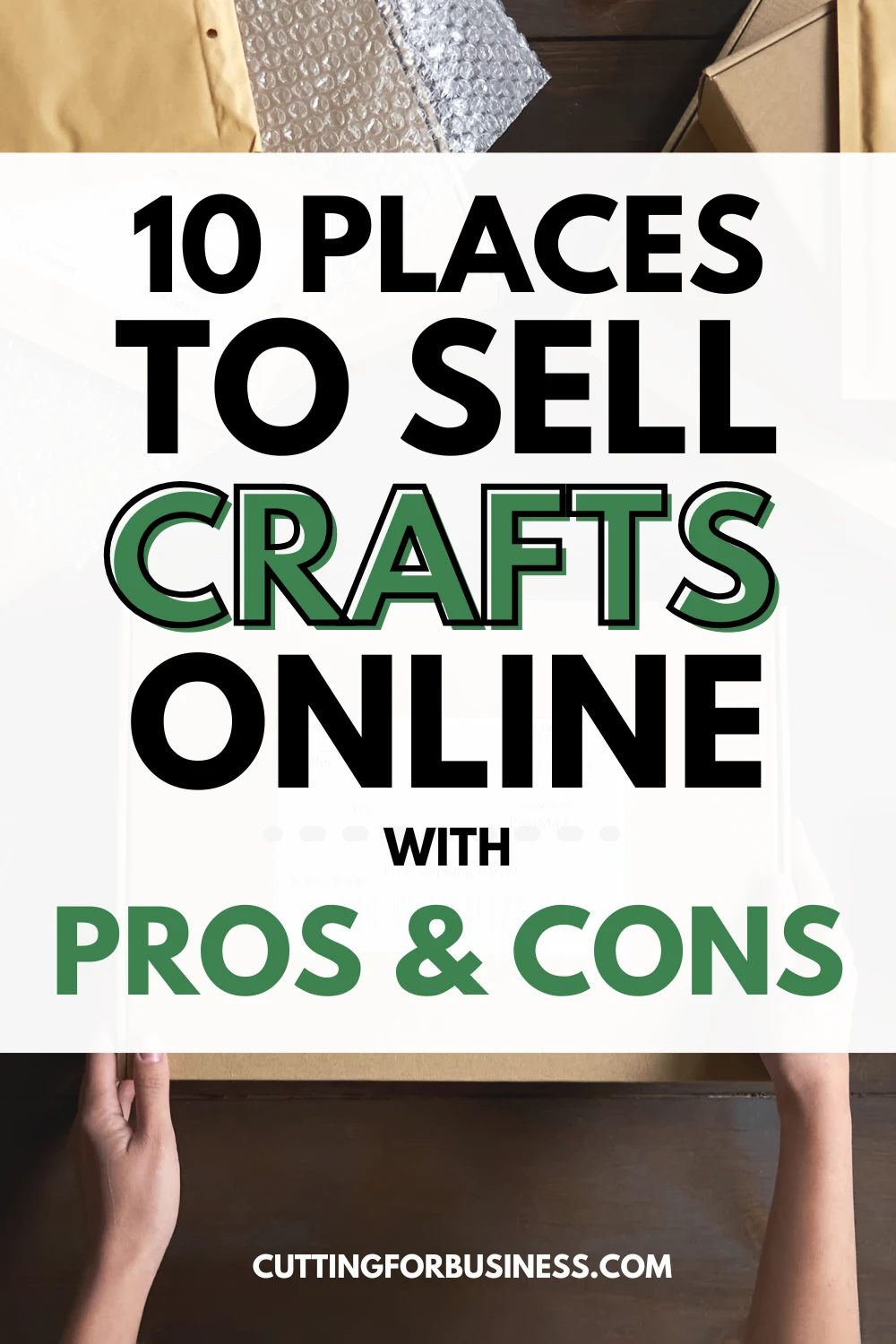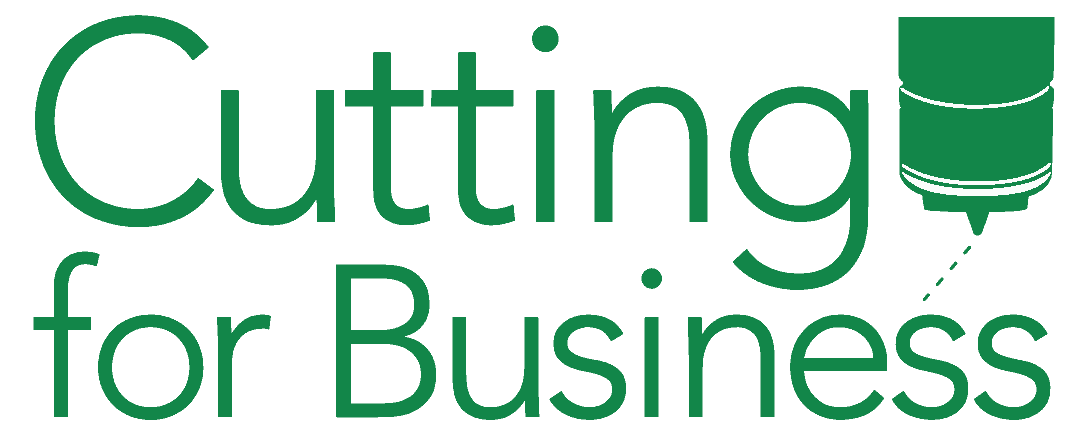Affiliate Disclosure: As an Amazon Associate I earn from qualifying purchases. Additionally, I may get commissions for purchases made through other affiliate links in this post.
Wondering where to sell your crafts online? Thinking about selling handmade products made with your Silhouette or Cricut?
I’ve compiled a list of places to sell crafts online – and I’ve included some pros and cons to each.

Table of Contents
10 Places to Sell Crafts Online
Locally/Word-of-Mouth
When first starting out, your friends and family make great customers. It is not uncommon to give a gift to a friend or family member, and have them return to you to ask you to create something for them.
- Pro: Friends and family want to see you succeed, and will often pass on your information to their friends.
- Con: Friends and family often want items made for really cheap (or free!) – remember to take into account your time, supplies, and talents.
- Costs: Free. Don’t forget to give your friends and family members business cards.
Locally Online
Most areas have local Buy and Sell groups through Facebook, Facebook Marketplace, and hyperlocal apps.
- Pro: It’s usually free to list in these groups.
- Con: With region specific groups, you have a limited market.
- Cost: Free.
Craft Shows, Fairs, and Co-ops
These types of sales require you to bring items to a location and set up a display with other crafters.
- Pro: Potential buyers can see and touch your items, and meet you in person.
- Con: Depending on your location, craft fairs may be hard to find. Also, it is a lot of work to haul items to a place, set up a display, and take it all down later. Some craft fairs require submitting products for sale before acceptance into the show, while others require you be legally set up as a business – so be sure to get information in advance.
- Costs: Range from a few dollars for a local crafts fair to $1000’s for well known shows.
Local Stores and Boutiques
Local stores and boutiques will often accept items to be sold in their store from crafters. Arrangements are often made based on a commission or consignment model.
- Pro: Local stores can increase your exposure.
- Con: Dealing with store owners, potential theft, and damaged products can be difficult. Make sure to have your agreement in writing.
- Costs: Vary from store to store.
Etsy
Probably the most well known and popular marketplace for handmade items online.
- Pro: Lots of buyers, and easy to set up, relatively inexpensive.
- Con: Lots of competition and many shops may offer items similar to your own. Finding a name that isn’t in use for your Etsy shop can be difficult. Additionally, many overseas importers are on the site selling goods for a fraction of the price of actual handmade.
- Cost: Setting up a shop is free, and each item listed is $0.20 for four months (or until sold – whichever comes first). For items that sell, an additional fee is required. Additionally, payment processing costs may apply.
Shopify
In contrast to Etsy, Shopify is an online ecommerce platform that many crafters sell through.
- Pro: More creative control over layouts than Etsy and a number of extensions to add functionality to your site.
- Con: Shopify doesn’t drive traffic to your shop. It is similar to having your own standalone website.
- Cost: $29 to $299 per month.
Amazon Handmade
Amazon has its own division of the website for handmade products.
- Pro: Amazon mixes Handmade on Amazon products with regular catalog products for better exposure.
- Con: It can be difficult and slow to get accepted into Amazon Handmade.
- Cost: Handmade deducts a 15% referral fee, with no additional listing or payment processing fees.
Your Website
A stand alone website that you create (or you pay to have a web designer create).
- Pro: Low amount of overhead costs for selling items.
- Con: Time consuming to set up, there is a constant need to promote your website to drive traffic to it, and sales are often slow (or non-existent) until your website is well established.
- Cost: Free to $1000’s.
Social Media
Many social media channels have a way to sell directly in the app or through the platform.
- Facebook: Crafters can sell through Facebook Groups, Marketplace, or your own Business Page. Remember, it is against the terms and conditions to sell through your personal page.
- Pro: Facebook is the largest social media network online. Selling on Facebook is well suited to people that have a large amount of friends that will help support the new business page by liking posts and sharing them.
- Con: Facebook is constantly changing their algorithms for pages, which means the posts you make from your business page may only be shown to a small portion of people that “like” your page. Most recently, Facebook is pushing for business pages to pay for ads on Facebook to receive exposure.
- Cost: Marketplace fees vary. There is no fee to sell in Facebook Groups or Marketplace.
- Instagram: Crafters can sell products with Instagram Shopping directly in the app.
- Pro: Instagram is highly visual with a supportive handmade community.
- Con: You must use amazing photos to be successful on Instagram.
- Cost: The fees can be steep at 5% flat fee per shipment. For products under $8.00, a flat fee of $0.40 is charged.
- TikTok: Through Shopify, crafters can sell directly on TikTok.
- Pro: TikTok is growing at a rapid pace.
- Con: Selling directly on TikTok is limited to a few partnerships at the moment, but there is a strong suspicion that TikTok Shops is on the way.
- Cost: Currently through Shopify or Teespring.
- Pinterest: Crafters can on Pinterest through Pinterest Shopping.
- Pro: Pinterest continues to be a high traffic site.
- Con: You’ll still need a site for users to actually purchase through.
- Cost: Using Pinterest Shopping features are free.
Smaller Marketplaces
There are a number of smaller marketplaces that are either very niche, are up and coming, or area out of the United States. Here are a few of them:
- Artfire.com: Artfire is an artisan marketplace that was built by artisans for artisans. In addition to handmade items, you can also find artisan goods, fine art, supplies, and more.
- Folksy: Folksy is an online marketplace for handmade goods and craft supplies based in the U.K.
- Misi: Misi is an other online marketplace for handmade products based in the U.K.
- Ebay: Over the years, Ebay has evolved into a wonderful place to sell items. Handmade items don’t do as well as they used to on Ebay.
- iCraft: Icraft is a smaller marketplace for handmade products.
- Mercari: Mercari is an app that allows selling all kinds of products. Some crafters do well on the platform.
- Goimagine: Goimagine is an up and coming marketplace that donates its profits to charity. I’ve written an article on Goimagine with more information about the marketplace.
- IndieCart: IndieCart (formerly Hyena Cart) is an older marketplace that has been merged with Hyena Cart. The marketplace offers handmade goods.
- Felt: Felt is an online platform for crafters based in New Zealand.
Where Do I Recommend You Sell?
I often give this advice to new sellers when they ask me where the best place to sell is: First, start with your friends and family. This allows you to get a feel for selling products and dealing with customers.
Next, open a shop on Etsy or another marketplace. Etsy is a great first step into online selling, because they can provide the buyers.
Last, strive to move to your own website. After you master online selling, stop relying on a marketplace and quit paying the fees. After you’ve started your own website, feel free to leave your Etsy store (or other marketplace) open with a limited number of products to help drive traffic to your website. This idea may seem overwhelming at first, but remember to start small and take it one step at a time.
The first step to selling your handmade items is setting some goals for your new business, so read on.
Since 2015, Christine Schinagl has been helping crafters start and run craft businesses through her blog, Cutting for Business. As a Silhouette and Cricut crafter herself, she has a unique take on what works and what doesn’t work in the craft business world. She also enjoys teaching other crafters how to create digital SVG designs, available at through the Design with Me series.

butre
Tuesday 25th of July 2023
awesome products
Christine Schinagl, Cutting for Business
Wednesday 26th of July 2023
:)